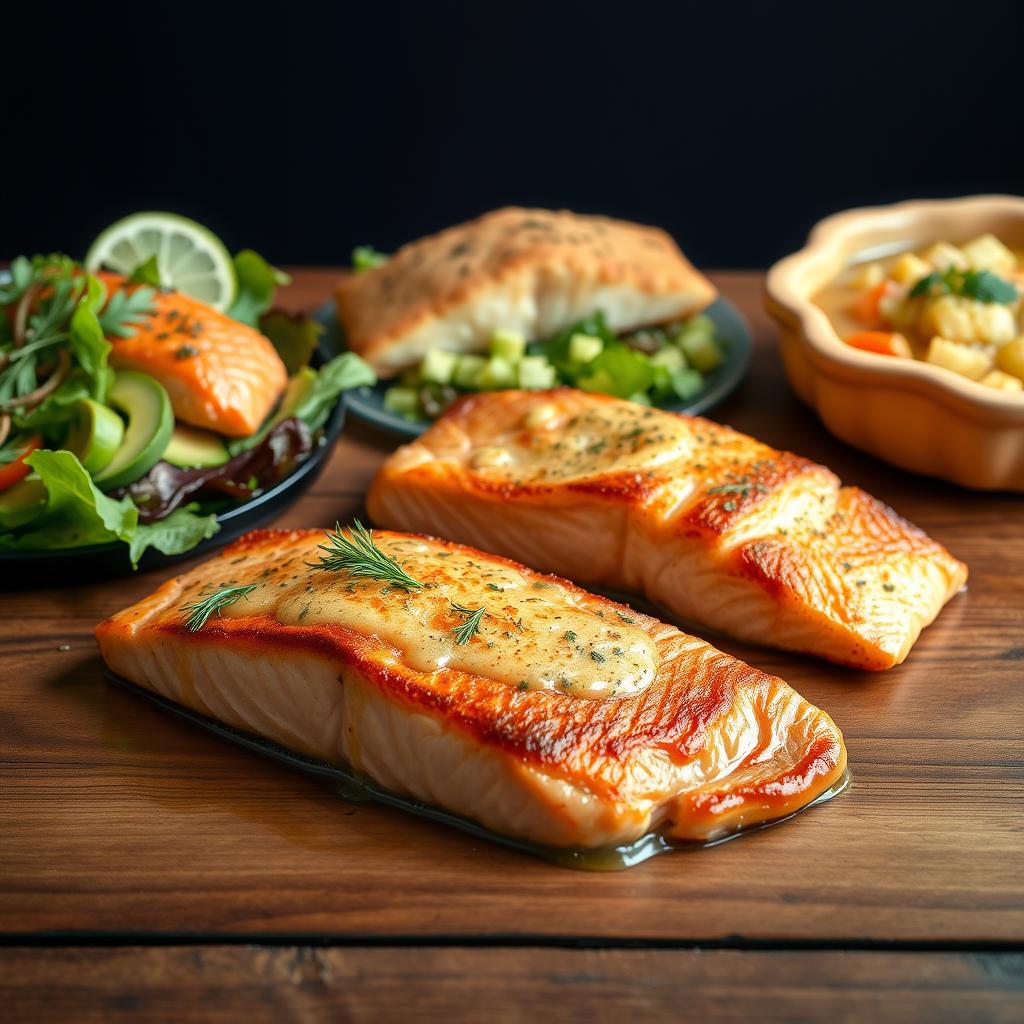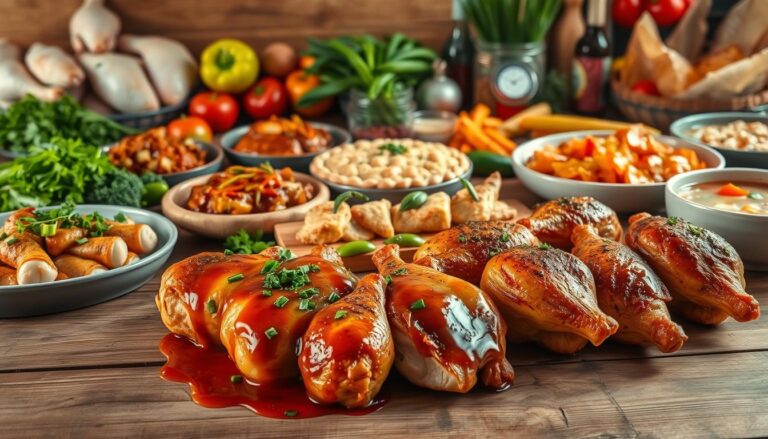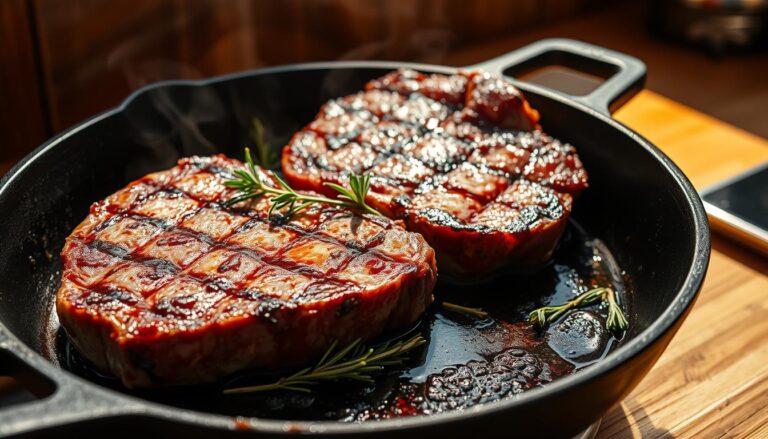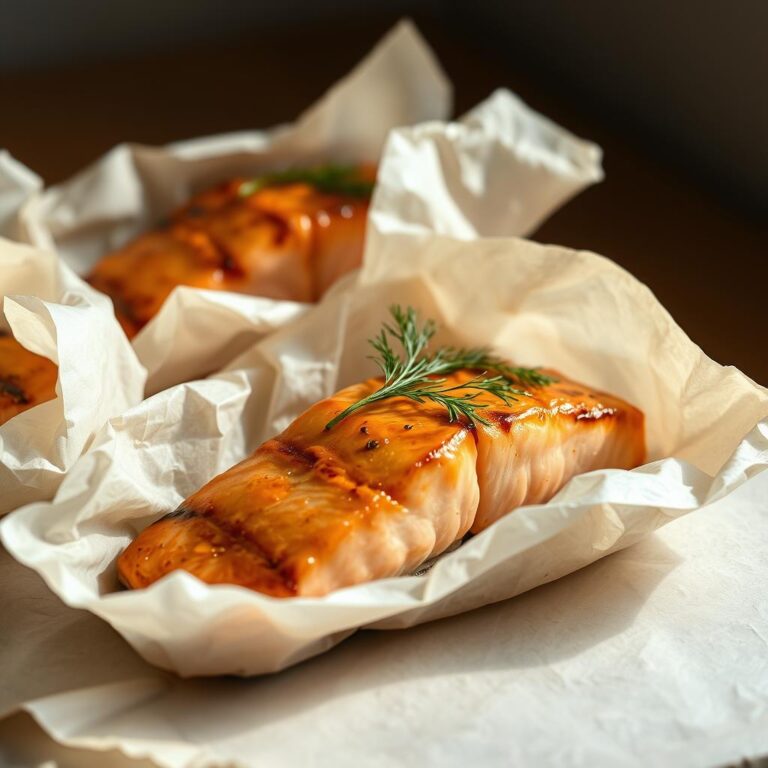How to Cook Salmon: 5 Simple and Tasty Salmon Recipes
Every family has a special recipe that makes dinner unforgettable. For me, salmon is that magic ingredient. It turns a simple meal into a feast. Cooking salmon might seem hard, but with the right methods, you can cook like a pro at home.
These salmon recipes are perfect for both experienced cooks and beginners. They’ll help you make meals that wow your loved ones. You’ll learn to make salmon crispy on the outside and tender on the inside.
Our recipes are easy to follow and full of flavor. You’ll pick up key cooking skills. These will help you make dishes that rival those from restaurants, all from your kitchen.
Key Takeaways
- Master multiple salmon cooking techniques
- Learn how to select the freshest salmon
- Understand proper temperature and cooking times
- Discover versatile seasoning options
- Create restaurant-quality salmon dishes at home
Understanding Different Types of Salmon
Salmon is a versatile and nutritious fish with several exciting varieties. Knowing the different types of salmon helps you choose the best for your meals. This ensures a delicious meal every time.
Wild vs Farmed Salmon: What’s the Difference?
Wild salmon and farmed salmon are the two main types. Wild salmon swim freely in the ocean, gaining rich flavors and nutrients naturally. Farmed salmon, raised in controlled environments, offer a consistent and often more affordable choice.
- Wild salmon typically have:
- More intense flavor
- Higher omega-3 content
- Less environmental impact
- Farmed salmon provide:
- Lower cost
- Year-round availability
- More predictable size
Popular Salmon Varieties
The Pacific Ocean is home to five main wild salmon types that seafood fans love:
| Salmon Variety | Flavor Profile | Best Cooking Method |
|---|---|---|
| Chinook (King) | Rich, buttery | Grilling, baking |
| Sockeye | Deep red, robust | Broiling, pan-searing |
| Coho | Mild, delicate | Poaching, steaming |
| Pink | Light, subtle | Canning, salads |
| Chum | Lean, mild | Smoking, grilling |
How to Choose Fresh Salmon
When picking salmon, look for bright, firm flesh with a fresh ocean smell. Stay away from fish with discoloration or a strong fishy smell. Fresh wild salmon or high-quality farmed salmon will give you the best cooking results.
Essential Kitchen Tools and Equipment
Getting ready to cook salmon? You need the right kitchen tools. The right tools can make your salmon dishes taste like they’re from a restaurant. Both pros and home cooks agree: good tools are key to great results.
Here are the must-haves for cooking salmon:
- Cast-iron skillet for crispy salmon skin
- Baking sheet with rimmed edges for oven-baked salmon
- Instant-read digital thermometer for exact temperatures
- Sharp fillet knife for clean cuts
- Silicone pastry brush for marinades and glazes
Choose tools that help you control temperature and keep the fish tender. A good non-stick pan or a seasoned cast-iron skillet is perfect. They help you get a crispy outside and a moist inside.
Here are more tools to take your salmon cooking to the next level:
- Wooden cutting board with juice groove
- Kitchen tongs for easy flipping
- Aluminum foil for wrapping and steaming
- Parchment paper for clean, easy cooking
You don’t have to spend a lot to get good tools. Start with the basics and add more as you get better at cooking salmon.
How to Cook Salmon
Learning how to cook salmon can make you a better cook. It’s great for beginners and experienced cooks alike. Knowing the right techniques will help you make delicious salmon every time.
Salmon is a versatile fish that cooks well with different methods. The key is to pick the right temperature and cooking time for each method.
Preparation Techniques
Before you start cooking, prepare your salmon with these steps:
- Pat the salmon dry with paper towels
- Remove any pin bones carefully
- Season generously with salt and pepper
- Let the fish rest at room temperature for 15 minutes
Temperature Guidelines
The ideal salmon temperature for safe eating is 145°F (63°C). Always use a meat thermometer to check the temperature.
| Cooking Method | Internal Temperature | Recommended Doneness |
|---|---|---|
| Baking | 145°F | Fully cooked, flaky |
| Grilling | 135-140°F | Medium, slightly translucent |
| Pan-Searing | 125-130°F | Medium-rare, tender |
Cooking Times
The cooking time for salmon depends on its thickness and the cooking method. Typically, plan for 4-6 minutes per half-inch of thickness.
- Thin fillets (1/2 inch): 3-4 minutes
- Medium fillets (1 inch): 5-7 minutes
- Thick fillets (1.5 inches): 8-10 minutes
Remember, the right temperature and cooking time are key. They help you achieve perfectly cooked, moist, and flavorful fish.
Classic Honey Garlic Butter Salmon
Discover the ultimate honey garlic salmon recipe. It turns a simple fish dinner into a masterpiece. This recipe mixes sweet honey with rich garlic for a delicious glaze.
The secret to perfect honey garlic salmon is balancing flavors and cooking. Use high-quality salmon fillets for the best taste. Fresh ingredients are key to an exceptional dish.
- Select fresh salmon with bright, firm flesh
- Use real butter for maximum flavor
- Choose local honey for a richer taste
- Mince fresh garlic for intense aroma
Making this butter salmon recipe is surprisingly easy. The goal is to make a glaze that caramelizes well and keeps the salmon tender. Your kitchen will smell amazing, promising a tasty meal.
Pro tip: For the most succulent honey garlic salmon, cook the fish until it reaches 145°F. This ensures it’s flaky and melts in your mouth.
Sheet Pan Lemon Herb Salmon
Weeknights can be busy, but dinner doesn’t have to be stressful. Sheet pan salmon is a great choice. It’s easy to make and tastes amazing. This recipe will be your new favorite way to cook dinner.
Ingredient Selection
Choosing the right ingredients is key for a delicious sheet pan salmon. Pick fresh salmon that looks good and smells right. The herbs you choose will also make a big difference in the taste.
- Fresh salmon fillets (wild-caught preferred)
- Organic fresh herbs (rosemary, thyme, parsley)
- Organic lemons
- Extra virgin olive oil
- Sea salt and fresh cracked pepper
Step-by-Step Instructions
Making sheet pan salmon is easy and fun. Just remember to season it right and cook it for the right amount of time.
- Preheat oven to 400°F
- Pat salmon fillets dry with paper towels
- Arrange fillets on lined sheet pan
- Drizzle olive oil
- Sprinkle chopped herbs generously
- Add lemon slices on top
- Season with salt and pepper
- Bake for 12-15 minutes
Serving Suggestions
Make your sheet pan salmon even better with some tasty sides. Try roasted veggies or quinoa. They’re easy to make and go great with the salmon.
| Side Dish | Preparation Time | Flavor Profile |
|---|---|---|
| Roasted Asparagus | 15 minutes | Light, crisp |
| Herbed Quinoa | 20 minutes | Nutty, wholesome |
| Garlic Roasted Potatoes | 30 minutes | Rich, savory |
Your sheet pan salmon dinner will taste like it came from a restaurant. It’s simple to make and healthy. Try different herbs and enjoy a quick and tasty meal.
Pan-Seared Salmon with Crispy Skin
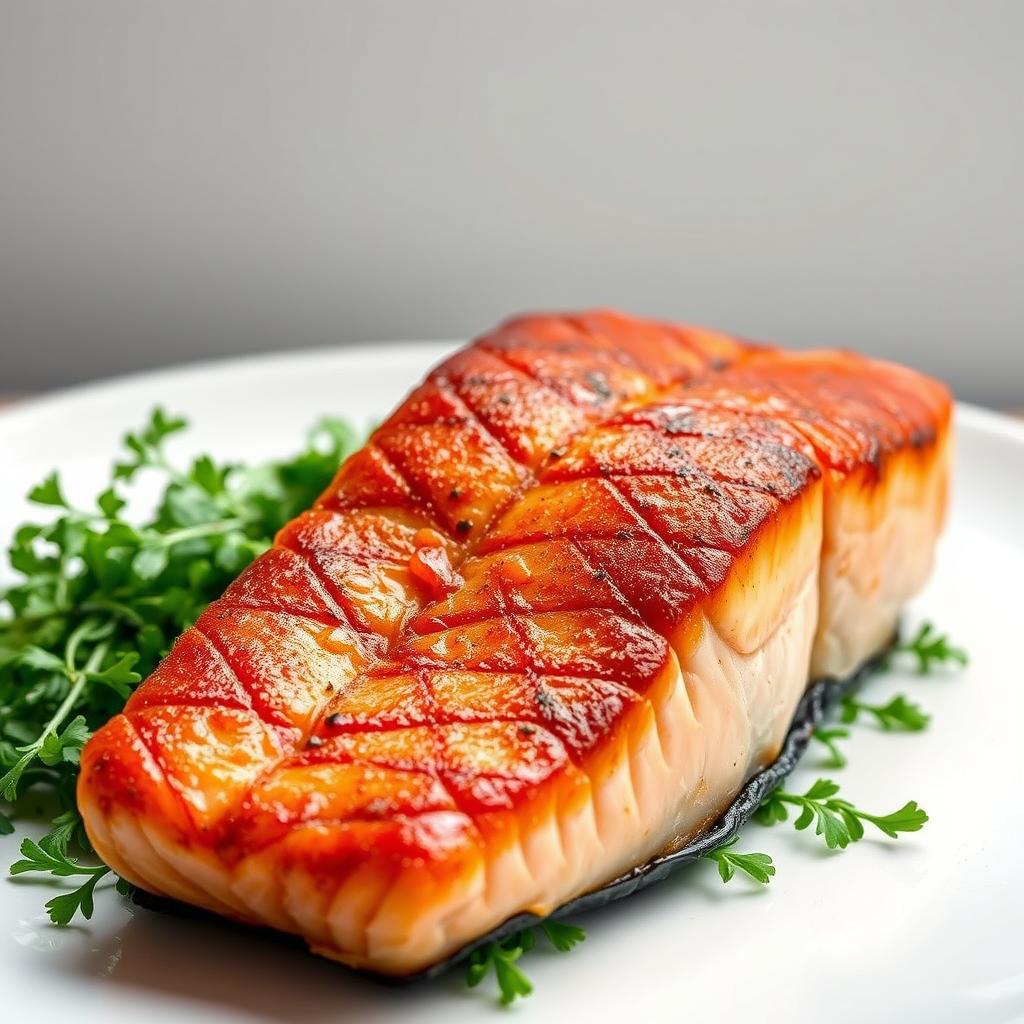
Making pan-seared salmon with crispy skin is an art. It turns a simple meal into a dish fit for a restaurant. The secret to success lies in a few key techniques.
Begin by picking a fresh salmon fillet with the skin on. Dry the salmon with paper towels. This step is key for crispy skin.
- Choose a heavy-bottomed skillet for even heat distribution
- Use high smoke point oils like avocado or grapeseed
- Ensure the pan is hot before adding the salmon
Season the fish with salt and pepper before cooking. Place the salmon skin-side down in a hot skillet. Press gently with a spatula to ensure maximum skin contact with the pan. Cook for 3-4 minutes until the skin is golden and crisp.
The secret to crispy skin is keeping the pan at the right temperature. Don’t move the fish too much. Let the skin get a beautiful golden-brown crust before flipping to cook the flesh side for 2-3 minutes more.
Pro tip: Take the salmon off the heat when it reaches 145°F. This ensures it’s cooked just right, moist, and full of flavor.
Simple Baked Salmon in Foil
Baking salmon in foil is a great choice for those who want a tasty, healthy meal with little cleanup. This method keeps the fish moist and flavorful. It also protects it from direct heat.
Seasoning Options
There are many ways to season your baked salmon in foil. Here are some tasty options:
- Lemon and dill
- Garlic and herb
- Honey mustard
- Cajun spice blend
- Teriyaki glaze
Cooking Method
To bake salmon in foil perfectly, just follow these steps:
- Preheat oven to 400°F
- Pat salmon dry with paper towels
- Season generously
- Wrap fish in aluminum foil
- Bake for 12-15 minutes
Storage Tips
Keep leftover salmon in a sealed container in the fridge. It stays good for up to three days. For the best taste, eat it within 24-48 hours. Reheat it gently to avoid overcooking.
Pro tip: Always check salmon’s internal temperature reaches 145°F for safe consumption.
Best Seasonings and Marinades for Salmon
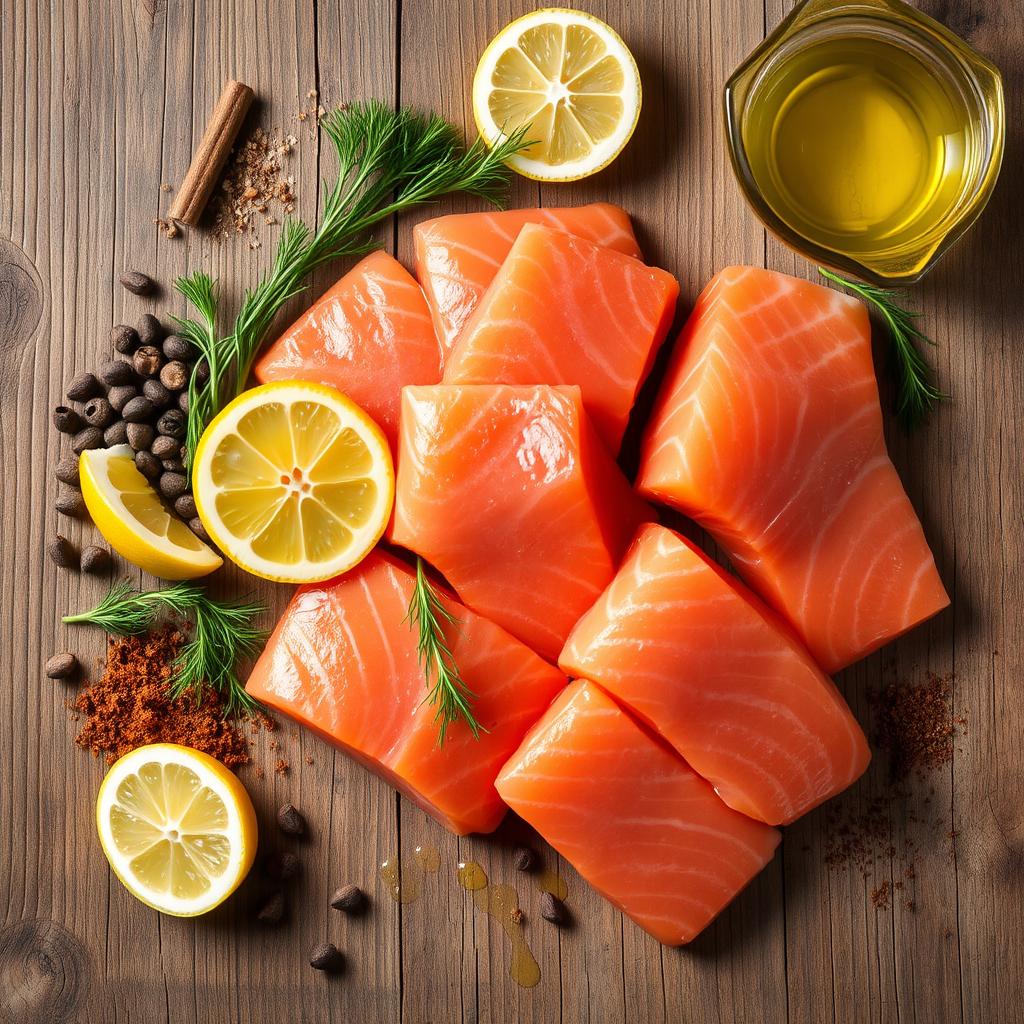
Turning your salmon into a standout dish begins with the right seasonings and marinades. Understanding how various flavors can enhance this fish is key.
Dry seasonings are a quick way to add flavor to your meal. Some great options include:
- Lemon pepper
- Cajun spice blend
- Dill and herb mix
- Smoked paprika rub
For marinades, aim for flavors that complement the fish’s richness. Citrus-based marinades are excellent, as they tenderize the fish and add a zesty taste.
| Marinade Type | Key Ingredients | Flavor Profile |
|---|---|---|
| Asian-Inspired | Soy sauce, ginger, garlic | Umami and savory |
| Honey Citrus | Honey, lemon, orange zest | Sweet and tangy |
| Mediterranean | Olive oil, herbs, lemon | Fresh and herbaceous |
Remember, marinate salmon for 15-30 minutes max. Longer times can make it mushy or too acidic. Always refrigerate and pat dry before cooking for a great sear.
Try out different seasonings to find your favorite. Whether you like bold Cajun spices or light herbs, there’s a perfect seasoning for your next salmon dish.
Common Cooking Mistakes to Avoid
Cooking salmon can be tricky, even for experienced home chefs. Knowing common mistakes helps you cook perfect fish every time. The key is to avoid pitfalls that can ruin your meal.
Common mistakes include temperature control, seasoning, and timing. By fixing these issues, you can improve your salmon cooking. This will make your meals more delicious.
Temperature Control Challenges
Overcooking salmon is a common mistake. It makes the fish dry and tough. To avoid this, use a meat thermometer and aim for 145°F.
- Watch for visual cues like opaque color and easy flaking
- Remove salmon from heat when it’s slightly translucent in the center
- Let residual heat finish cooking the fish
Seasoning Strategies
Seasoning is key to a great salmon dish. Too little seasoning makes it bland, while too much hides its flavor. Find a balance with herbs and spices.
| Seasoning Mistake | Solution |
|---|---|
| Over-salting | Use light salt touch, let fish’s natural flavor shine |
| Bland seasoning | Experiment with fresh herbs, citrus zest |
| Heavy marinades | Choose light, complementary flavors |
Timing and Preparation
Timing is key when cooking salmon. Thaw frozen salmon in the fridge, and let cooked salmon rest for 3-5 minutes. This makes it moist and flavorful.
Avoiding these mistakes can make your seafood dishes amazing. Practice, patience, and detail are essential for mastering salmon cooking.
Conclusion
Cooking salmon doesn’t have to be scary. This guide has given you tips to make your kitchen a place for tasty seafood. Every chef began somewhere, and learning to cook salmon is a skill that grows with practice.
To master salmon cooking, learn the basics. Choose high-quality fish, know the best cooking methods, and try new seasonings. Whether you like pan-seared, baked, or grilled salmon, these methods can make your meals amazing. Your confidence will grow with each dish you try.
Cooking is like an art. Don’t be afraid to try new flavors or cooking ways. The more you cook, the easier it will become. Your family and friends will love the delicious seafood dishes you’ll make.
Begin your salmon cooking journey today. With these tips and insights, you’re ready to improve your cooking skills. Enjoy nutritious, tasty meals that show off the amazing versatility of this popular fish.

